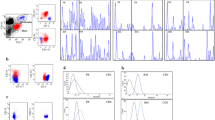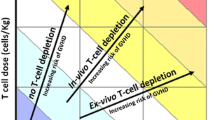Abstract
After conventional (“unmanipulated”) allogeneic hematopoietic cell transplantation, eradication of residual disease, i.e., the so-called graft-versus-leukemia (GvL) effect, depends on donor T-lymphocytes which recognize host histocompatibility antigens on leukemic cells. However, this transplant is far from optimal because it is associated with high incidence of relapse and risk of graft-versus-host disease (GvHD). Recent clinical trials suggest that adoptive immunotherapy with regulatory and conventional T-lymphocytes prevents GvHD while allowing a GvL effect in acute leukemia patients undergoing T-cell-depleted-haploidentical transplantation. We discuss the clinical relevance of this new immunotherapeutic strategy and the mechanisms underlying the separation of GvL effect from GvHD.
Access this chapter
Tax calculation will be finalised at checkout
Purchases are for personal use only
Similar content being viewed by others
References
Weiden PL, Flournoy N, Thomas ED, et al. Antileukemic effect of graft-versus-host disease in human recipients of allogeneic-marrow grafts. N Engl J Med. 1979;300:1068–73.
Horowitz MM, Gale RP, Sondel PM, et al. Graft-versus-leukemia reactions after bone marrow transplantation. Blood. 1990;75:555–62.
Kloosterman TC, Martens AC, van Bekkum DW, et al. Graft-versus-leukemia in rat MHC-mismatched bone marrow transplantation is merely an allogeneic effect. Bone Marrow Transplant. 1995;15:583–90.
Bortin MM, Truitt RL, Rimm AA, et al. Graft-versus-leukaemia reactivity induced by alloimmunisation without augmentation of graft-versus-host reactivity. Nature. 1979;281:490–1.
Reddy P, Maeda Y, Liu C, et al. A crucial role for antigen presenting cells and alloantigen expression in graft-versus-leukemia responses. Nat Med. 2005;11:1244–9.
Rezvani K, Barrett AJ. Characterizing and optimizing immune responses to leukaemia antigens after allogeneic stem cell transplantation. Best Pract Res Clin Haematol. 2008;21:437–53.
Gupta V, Talllman MS, He W, et al. Comparable survival after HLA-well matched unrelated or matched sibling donor transplantation for acute myeloid leukemia in first remission with unfavourable cytogenetics at diagnosis. Blood. 2010;116:1839–48.
Scaradavou A, Brunstein CG, Eapen M, et al. Double unit grafts successfully extend the application of umbilical cord blood transplantation in adults with acute leukemia. Blood. 2013;121:752–8.
Verneris MR, Brunstein CG, Barker JN, et al. Relapse risk after umbilical cord blood transplantation: enhanced graft-versus-leukemia effect in recipients of two units. Blood. 2009;114:4293–9.
Rocha V, Labopin M, Mohty M, et al. Outcomes after double unit unrelated cord blood transplantation (UCBT) compared with single UCBT in adults with acute leukemia in remission. A Eurocord and ALWP Collaboration study In abstract of ASH Annual Meeting. Blood. 2010;116:910a.
Aversa F, Tabilio A, Terenzi A, et al. Successful engraftment of T-cell-depleted haploidentical “three-loci” incompatible transplants in leukemia patients by addition of recombinant human granulocyte colony-stimulating factor-mobilized peripheral blood progenitor cells to bone marrow inoculum. Blood. 1994;84:3948–55.
Aversa F, Tabilio A, Velardi A, et al. Treatment of high-risk acute leukemia with T-cell-depleted stem cells from related donors with one fully mismatched HLA haplotype. N Engl J Med. 1998;339:1186–93.
Aversa F, Terenzi A, Tabilio A, et al. Full haplotype-mismatched hematopoietic stem-cell transplantation: a phase II study in patients with acute leukemia at high risk of relapse. J Clin Oncol. 2005;23:3447–54.
Ciceri F, Labopin M, Aversa F, et al. A survey of fully haploidentical hematopoietic stem cell transplantation in adults with high-risk acute leukemia: a risk factor analysis of outcomes for patients in remission at transplantation. Blood. 2008;112:3574–81.
Ruggeri L, Capanni M, Urbani E, et al. Effectiveness of donor natural killer cell alloreactivity in mismatched hematopoietic transplants. Science. 2002;295:2097–100.
Ruggeri L, Mancusi A, Capanni M, et al. Donor natural killer cell allorecognition of missing self in haploidentical hematopoietic transplantation for acute myeloid leukemia: challenging its predictive value. Blood. 2007;110:433–40.
Mancusi A, Ruggeri L, Urbani E, et al. Haploidentical hematopoietic transplantation from KIR ligand-mismatched donors with activating KIRs reduces non-relapse mortality. Blood. 2015;125:3173–82.
Luznik L, O’Donnell P, Symons H, et al. HLA-haploidentical bone marrow transplantation for hematologic malignancies using nonmyeloablative conditioning and high-dose, posttransplantation cyclophosphamide. Biol Blood Marrow Transplant. 2008;14:641–50.
Ciurea SO, Zhang M-J, Bacigalupo A, et al. Haploidentical transplant with post-transplant cyclophosphamide versus matched unrelated donor transplant for acute myeloid leukemia. Blood. 2015;126:1033–40.
Huang X-J, Liu D-H, Liu K-Y, et al. Haploidentical hematopoietic stem cell transplantation without in vitro T-cell depletion for the treatment of hematological malignancies. Bone Marrow Transplantation. 2006;38:291–7.
Di Bartolomeo P, Santarone S, De Angelis G, et al. Haploidentical, unmanipulated, G-CSF-primed bone marrow transplantation for patients with high-risk hematologic malignancies. Blood. 2013;121:849–57.
Wang Y, Liu QF, LP X, et al. Haploidentical vs identical-sibling transplant for AML in remission: a multicenter, prospective study. Blood. 2015;125:3956–62.
Arcese W, Picardi A, Santarone S, et al. Haploidentical, G-CSF-primed, unmanipulated bone marrow transplantation for patients with high-risk haematological malignancies: an update. Bone Marrow Transplant. 2015;50:S24–30.
Sakaguchi S, Sakaguchi N, Asano M, et al. Immunologic self-tolerance maintained by activated T cells expressing IL-2 receptor alpha-chains (CD25). Breakdown of a single mechanism of self-tolerance causes various autoimmune diseases. J Immunol. 1995;155:1151–64.
Hoffmann P, Ermann J, Edinger M, et al. Donor-type CD4(+)CD25(+) regulatory T cells suppress lethal acute graft-versus-host disease after allogeneic bone marrow transplantation. J Exp Med. 2002;196:389–99.
Nguyen VH, Zeiser R, daSilva DL, et al. In vivo dynamics of regulatory T-cell trafficking and survival predict effective strategies to control graft-versus-host disease following allogeneic stem cell transplantation. Blood. 2007;109:2649–56.
Nguyen VH, Shashidhar S, Chang DS, et al. The impact of regulatory T cells on T cell immunity following hematopoietic cell transplantation. Blood. 2008;111:945–53.
Taylor PA, Lees CJ, Blazar BR. The infusion of ex vivo activated and expanded CD4+CD25+ immune regulatory cells inhibits graft-versus-host disease lethality. Blood. 2002;99:3493–9.
Cohen JL, Trenado A, Vasey D, et al. CD4(+) CD25(+) immunoregulatory T cells: new therapeutics for graft-versus host disease. J Exp Med. 2002;196:401–6.
Trenado A, Charlotte F, Fisson S, et al. Recipient type specific CD4+CD25+ regulatory T cells favour immune reconstitution and control graft-versus-host disease while maintaining graft-versus-leukemia. J Clin Invest. 2003;112:1688–96.
Bolton HA, Zhu E, Terry AM, et al. Selective Treg reconstitution during lymphopenia normalizes DC costimulation and prevents graft-versus-host disease. J Clin Invest. 2015;125:3627–41.
Gaidot A, Landau DA, Martin GH, et al. Immune reconstitution is preserved in hematopoietic stem cell transplantation coadministered with regulatory T cells for GVHD prevention. Blood. 2011;117:2975–83.
Edinger M, Hoffmann P, Ermann J, et al. CD4+CD25+ regulatory T cells preserve graft-versus-tumor activity while inhibiting graft-versus-host disease after bone marrow transplantation. Nat Med. 2003;9:1144–50.
Martelli MF, Di Ianni M, Ruggeri L, et al. HLA-haploidentical transplantation with regulatory and conventional T-cell adoptive immunotherapy prevents acute leukemia relapse. Blood. 2014;124:638–44.
Di Ianni M, Falzetti F, Carotti A, et al. Tregs prevent GVHD and promote immune reconstitution in HLA-haploidentical transplantation. Blood. 2011;117:3921–8.
Brunstein CG, Miller JS, McKenna DH, et al. Umbilical cord blood-derived T regulatory cells to prevent GVHD: kinetics, toxicity profile, and clinical effect. Blood. 2016;127:1044–51.
Brunstein CG, Miller JS, Cao Q, et al. Infusion of ex vivo expanded T regulatory cells in adults transplanted with umbilical cord blood: Safety profile and detection kinetics. Blood. 2011;117:1061–70.
Nishikawa H, Sakaguchi S. Regulatory T cells in tumor immunity. Int J Cancer. 2010;127:759–67.
Vence L, Palucka AK, Fay JW, et al. Circulating tumor antigen-specific regulatory T cells in patients with metastatic melanoma. Proc Natl Acad Sci U S A. 2007;104:20884–9.
Kelley TW, Parker CJ. CD4(+)CD25(+)FoxP3(+) regulatory T cells and haematological malignancies. Front Biosci. 2010;2:980–2.
Ustun C, Miller JS, Munn DH, et al. Regulatory T cells in acute myelogenous leukemia: is it time for immunomodulation? Blood. 2011;118:5084–95.
Ruggeri L, Di Ianni M, Falzetti F. Preventing GvHD and high-risk acute leukemia relapse by Treg and Tcon adoptive immunotherapy in HLA haploidentical transplantation: an update on the clinical trial and insights from murine studies. In Abstract EBMT, Istanbul; 2015.
Booth NJ, McQuaid AJ, Sobande T, et al. Different proliferative potential and migratory characteristics of human CD4+ regulatory T cells that express either CD45RA or CD45RO. J Immunol. 2010;184:4317–26.
Fujisaki J, Wu J, Carlson AL, et al. In vivo imaging of Treg cells providing immune privilege to the haematopoietic stem-cell niche. Nature. 2011;474:216–9.
Wong JYC, Liu A, Schultheiss T, et al. Targeted total marrow irradiation using three-dimensional image-guided tomographic intensity-modulated radiation therapy: an alternative to standard total body irradiation. Biol Blood Marrow Transplant. 2006;12:306–15.
Author information
Authors and Affiliations
Corresponding author
Editor information
Editors and Affiliations
Rights and permissions
Copyright information
© 2018 Springer International Publishing AG, part of Springer Nature
About this chapter
Cite this chapter
Martelli, M.F., Di Ianni, M., Ruggeri, L. (2018). Adoptive Immunotherapy with Regulatory and Conventional T-cells in Haploidentical T-cell Depleted Transplantation Protects from GvHD and Exerts GvL Effect. In: Ciurea, S., Handgretinger, R. (eds) Haploidentical Transplantation. Advances and Controversies in Hematopoietic Transplantation and Cell Therapy. Springer, Cham. https://doi.org/10.1007/978-3-319-54310-9_4
Download citation
DOI: https://doi.org/10.1007/978-3-319-54310-9_4
Published:
Publisher Name: Springer, Cham
Print ISBN: 978-3-319-54309-3
Online ISBN: 978-3-319-54310-9
eBook Packages: MedicineMedicine (R0)




